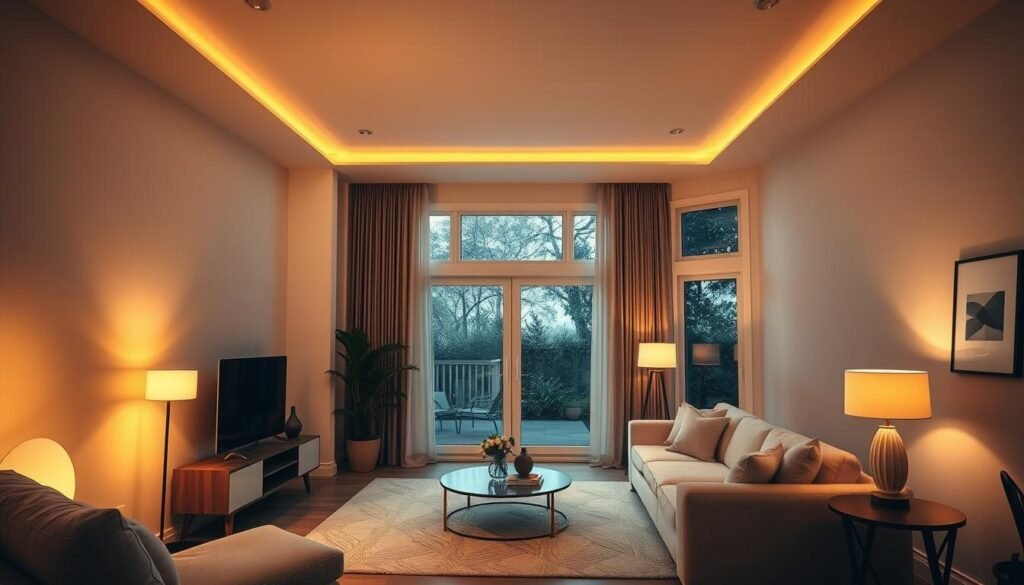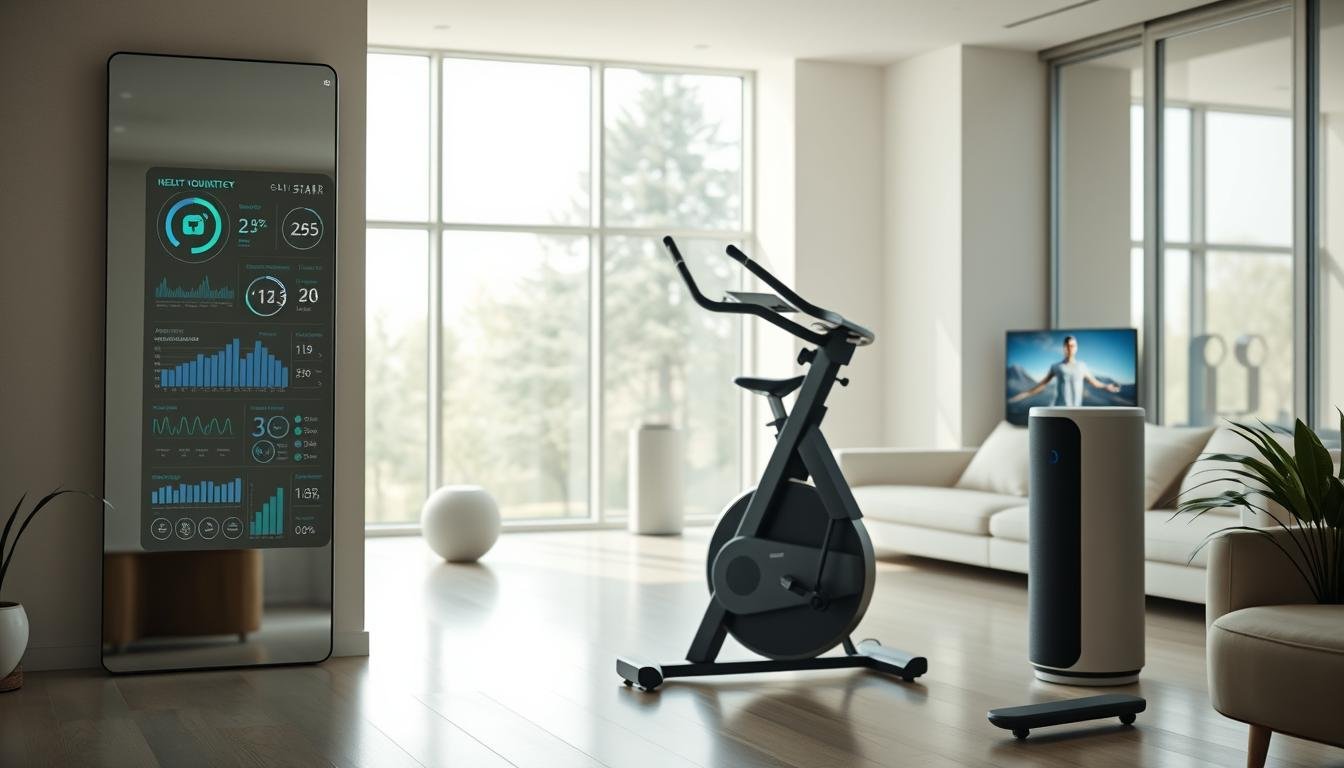This post may contain affiliate links. When you purchase through links on our site, we may earn an affiliate commission.
I never thought my living space could impact my energy levels until I discovered startling facts. The EPA reveals we spend 90% of our lives indoors – breathing air with pollutant levels 2-5 times higher than outside. Worse yet, the World Health Organization links poor indoor air to 8 million premature deaths yearly. That realization changed everything for me.
My journey began when chronic fatigue persisted despite clean eating and exercise. Traditional solutions failed until I started tracking hidden factors in my environment. Air quality sensors revealed spikes in volatile compounds every time I cooked. Water tests showed unexpected mineral imbalances. Even my lighting patterns disrupted sleep cycles.
Through trial and error, I found systems that transform spaces into health allies. These tools don’t just collect data – they actively improve conditions while teaching sustainable habits. The best part? Most adjustments feel effortless once set up.
Key Takeaways
- Indoor air pollution causes more health risks than most people realize
- Modern sensors detect invisible threats traditional methods miss
- Environmental factors impact both immediate comfort and long-term wellness
- Automated systems create healthier spaces without constant effort
- Small tech investments can yield significant quality-of-life improvements
Embracing the Future of Home Wellness
Three years ago, my kitchen became a classroom and my bedroom doubled as an office. This shift made me realize our living spaces needed to work harder for us. The pandemic didn’t just change where we live – it transformed how we exist within our walls.
https://www.youtube.com/watch?v=No6sLqAIcnI
Understanding the Impact of Our Home Environment
I started noticing patterns. Headaches faded when I adjusted humidity levels. Sleep improved after swapping harsh bulbs for circadian-friendly lighting. Simple changes created ripple effects across my family’s well-being.
How Technology Transforms Everyday Living
Modern systems act like silent guardians. My air purifier now detects allergens before I sneeze. Water filters automatically balance pH levels. These aren’t gadgets – they’re partners in creating healthier routines.
| Traditional Home | Tech-Enhanced Space | Key Benefits |
|---|---|---|
| Static environment | Adaptive conditions | Reduces allergy triggers |
| Manual adjustments | Automatic optimization | Saves 3+ hours weekly |
| Generic settings | Personalized profiles | Supports individual needs |
What surprised me most? These solutions help everyone differently. My niece concentrates better during study sessions with optimized lighting. My parents feel safer with motion sensors that detect falls. It’s like having a personal health coach built into our walls.
Smart home wellness tech: Optimizing Air, Water, and Lighting
My turning point came when I realized stale air and tap water weren’t just annoyances – they were stealthy health saboteurs. Companies like Pure 365 and Delos taught me how modern monitoring systems turn guesswork into actionable insights. Their devices now guard my space like invisible sentinels.

Breathing Easier With Intelligent Air Management
I used to think my nose could detect problems. Then real-time sensors revealed carbon monoxide spikes during fireplace use and VOC surges after cleaning. My Pure 365 hub now triggers purifiers before odors form. Delos’ humidity controls maintain 45% moisture – a sweet spot that cut my allergy meds by half.
Research shocked me: mold exposure in damp spaces raises asthma risks by 40%. Now, automated dehumidifiers kick in during showers, and I get alerts if basement moisture creeps above 50%. It’s like having a weather station tuned to my lungs’ needs.
Light That Works With Biology, Not Against It
Morning headaches vanished when I swapped blue-heavy bulbs for circadian-friendly ones. My lighting shifts from energizing cool tones at dawn to warm hues by dusk. Bedside lamps dim automatically as melatonin levels rise.
Water quality improvements surprised me most. Delos’ geo-specific filtration uses decade-old regional data to target local contaminants. Pure 365’s leak detectors once saved me from a ruptured pipe disaster. Both systems send water reports to my phone – no more mystery minerals.
These solutions work best when integrated. My air purifier talks to the thermostat, while water sensors trigger shutoffs during emergencies. It’s not just convenience – it’s a layered defense against invisible threats.
Creating My Healthy Home Oasis with Automated Systems
Sleep became my secret weapon for better health when I discovered how environmental factors shape rest quality. Nearly 40% of adults sleep fewer than seven hours nightly, according to CDC data. My solution? Letting automated systems handle the science while I reap the benefits.

Enhancing Sleep Hygiene Through Lighting and Temperature Control
My circadian-friendly bulbs now shift from energizing cool whites at dawn to warm amber tones by dusk. Ketra’s sunrise simulation gently wakes me better than any alarm. Motorized shades create total darkness by 9 PM, while the thermostat drops to 67°F – the sweet spot for deep sleep.
These changes delivered unexpected perks:
- Faster sleep onset (under 15 minutes vs. 45+ previously)
- Fewer midnight bathroom trips
- Consistent energy levels throughout the day
Integrating Entertainment and Acoustic Wellness
Noise pollution from street traffic used to disrupt my REM cycles. Now, sound-dampening panels and white noise generators create a tranquil bubble. My evening routine triggers cascading changes:
- Entertainment system volume gradually decreases
- Overhead lights dim to 10% brightness
- Bedside lamp shifts to reading-friendly warmth
The WHO wasn’t exaggerating – chronic noise exposure does impact cardiovascular health. Since implementing these changes, my resting heart rate dropped 8 beats per minute. That’s better than any meditation app achieved.
Reducing Stress and Transforming Daily Living
My mornings used to start with mental checklists – did I lock the doors? Adjust the thermostat? Now, automation handles these tasks silently. This shift didn’t just save time – it rewired how I experience daily life.

Seamless Security and Routine Automation
Tamper-proof locks with remote access changed how I manage deliveries and guests. Last week, I granted a neighbor temporary entry to water plants while traveling. Real-time alerts showed exactly when they entered and exited – no more guessing games.
Voice commands became my secret weapon against decision fatigue. A simple “goodnight” phrase triggers cascading actions: lights dim, doors lock, and alarms activate. This routine shaved 20 minutes off my bedtime prep while cutting anxiety about forgotten tasks.
Leak detectors under sinks once caught a dripping pipe during a work trip. The system automatically shut off water mains and texted my plumber. What could’ve been a $3,000 repair became a $120 fix. These safeguards create invisible safety nets that protect both property and peace of mind.
For families balancing virtual learning, automated charging stations ensure devices stay powered. My niece’s tablet now charges when her online classes end – no more frantic searches for cords. It’s surprising how these small solutions add up to major stress reduction.
By letting technology handle the mental load, I’ve reclaimed headspace for creative projects and family time. The true value isn’t in flashy gadgets – it’s the quiet confidence that comes from living in spaces that actively support our well-being.
Conclusion
Looking back, integrating these systems transformed how I approach daily living. What began as air quality fixes became a complete lifestyle shift. Science confirms it: our spaces directly influence long-term health outcomes more than we realize.
Viewing these upgrades as investments changed everything. Preventing issues costs less than treating them later – both financially and emotionally. My air filters and circadian lights work together like orchestra instruments, each enhancing the others’ benefits.
This approach isn’t about luxury. It’s building foundations for sustainable well-being. Just as plumbing and electricity became essentials, I believe proactive environmental controls will define future living standards.
The data speaks loudest: fewer headaches, better sleep, and consistent energy prove these changes matter. For anyone seeking to boost their quality of life, modern solutions offer measurable improvements that compound over time.
Our dwellings should nurture us, not just house us. With the right tools, they become active partners in crafting healthier tomorrows – one breath, sip, and sunrise at a time.

 using WordPress and
using WordPress and 
No responses yet